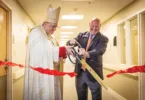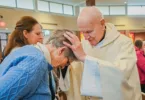
“Baptism of Jesus,” by Donald Jackson, Copyright 2002, The Saint John’s Bible, Order of Saint Benedict, Collegeville, Minnesota, USA. Scripture quotations are from the New Revised Standard Version of the Bible, Catholic Edition, Copyright 1993, 1989 National Council of the Churches of Christ in the United States of America. Used by permission. All rights reserved.
by Joe Bollig
joe.bollig@theleaven.org
ATCHISON — A Bible is a Bible is a Bible, right?
Wrong — especially if that Bible is The Saint John’s Bible, the first handwritten and illuminated Bible commissioned by a Benedictine monastery in more than 500 years.
This month and next, students and the public will have an opportunity to view an exhibition of 25 archival prints and a full-scale replica of the seven-volume masterpiece at Benedictine College and St. Benedict’s Abbey in Atchison.
The exhibition is free and open to the public.
Additionally, the Benedictine department of music will present a concert of musical works that explore the illuminated passages, and noted biblical scholar Sister Irene Nowell, OSB, will offer a special lecture. Sister Irene was part of the team that produced The St. John’s Bible.
This exhibition is co-sponsored by St. Benedict’s Abbey and the Benedictine College art department. The convocation and arts committee, a faculty group, is responsible for the exhibition. The prints and replica volume come from the Hill Museum & Manuscript Library at St. John’s Abbey and University in Collegeville, Minnesota.
Some instructors and professors are taking advantage of the exhibition to undertake interdisciplinary instruction, said Bryan Park, assistant professor in the art department, and coordinator of the effort to bring The St. John’s Bible exhibition to Atchison.
“It’s hard to know all the different ways they might be used, but the college is offering an interdisciplinary seminar class this semester,” he said.
Park will join one faculty member from each of departments of music, theology and history in teaching the class.
“The four of us will lead a group of 19 students to look at the history of the Bible and of illumination, the writing of the Bible, and how the writing, illumination and pictures go together to create spiritual meaning. We’re looking at the creation of the [manuscripts] and how the arts in general can be a part of religious and devotional practice.”
Glorious artwork surprised even contributor
Even though she was part of producing The St. John’s Bible, seeing its power and glory on display for the first time was a very moving experience for Sister Irene Nowell, OSB.
“The first exhibit was in Minneapolis,” said Sister Irene. “I was viewing all the illuminations. The Pentateuch was in one room, and I was really moved because I worked on it.”
“Then I turned the corner,” she continued, and “there was a little hallway leading into the room with the New Testament images. As I turned and looked up, right in front of me was the illumination from the beginning of the Gospel of John.”
“Because it’s gold — gold moves when you move, because of the reflection,” she added, “it looked just like Christ was walking toward me.
“I burst into tears. It was so moving — after we’d done all that work — to see how powerful it was.”
The St. John’s Bible came about when master calligrapher Donald Jackson, from the United Kingdom, told Father Eric Hollas, OSB, from St. John’s Abbey in Collegeville, Minnesota, about his desire to create a handwritten, illuminated Bible the way monks and nuns did during medieval times.
The abbey agreed to fund and sponsor the project, so Jackson and a team of artists, calligraphers, scholars and theologians worked from 2000 to 2011 to produce a seven-volume illuminated Bible.
Sister Irene was the Old Testament scholar of the eight-member committee on illuminations and texts that guided the artists and calligraphers.
“They had already decided which passages were to be illuminated,” said Sister Irene. “I would offer an interpretation of the passage and what I thought were highlights that could be illuminated, and what they might not realize about the Old Testament passage.”
There is a difference between an illustration and an illumination. For example, an illustrator would draw a sheep and shepherd for Psalm 23, but an illuminator would try to convey deeper meaning in a more symbolic and less literal sense.
“You can see in the illuminations of how, with art, we can bring the meaning of a passage into the 21st century. We wanted to use new images that would bring new insight into the meaning of the text,” said Sister Irene.
Like the earlier manuscripts produced in medieval times, The St. John’s Bible will serve as an inspiration for centuries.
“Father Eric Hollas said, ‘In 500 years, this [Bible] will be the only thing left for people to remember St. John’s by. All the buildings will be gone, but this will very likely be left,’” said Sister Irene.
“That’s pretty amazing.”
Exhibition times, locations and events
Archival prints exhibition:
Because no one space at Benedictine College is large enough to accommodate all of the 25 archival prints, they will be exhibited March 13 to April 16 at three locations:
- The McCarthy Gallery of Art in Bishop Fink Hall
- The Abbey Gallery on the lower level of the abbey church
- The foyer leading to the dining hall.
The galleries will be open Wednesdays, 2 to 8 p.m., and on Saturdays and Sundays from 12:30 to 4:30 p.m., or by appointment. The prints on display next to the dining hall will be available throughout the day.
Gospel and Acts of the Apostles exhibition:
A full-scale replica volume of the Gospels and Acts of the Apostles will be on display during Holy Week, April 9 – 15, in the main lobby of the library. This one volume will be available for viewing during normal library hours: Monday through Thursday, 7:45 a.m. to 11 p.m.; Friday, 7:45 a.m. to 5 p.m.; Saturday, noon to 5 p.m.; and Sunday ,1 to 11 p.m.






